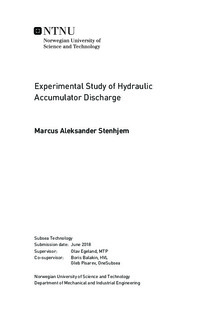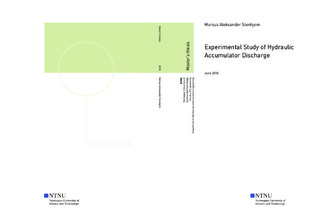| dc.contributor.advisor | Egeland, Olav | |
| dc.contributor.advisor | Balakin, Boris | |
| dc.contributor.advisor | Pisarev, Gleb | |
| dc.contributor.author | Stenhjem, Marcus Aleksander | |
| dc.date.accessioned | 2018-09-07T14:02:05Z | |
| dc.date.available | 2018-09-07T14:02:05Z | |
| dc.date.created | 2018-06-10 | |
| dc.date.issued | 2018 | |
| dc.identifier | ntnudaim:18907 | |
| dc.identifier.uri | http://hdl.handle.net/11250/2561552 | |
| dc.description.abstract | This thesis aims to identify the behaviour of a 4 l hydraulic bladder accumulator undergoing
discharge under various conditions and ultimately shed some light on irregularities
that OneSubsea Processing is experiencing regarding rapid initial pressure reduction in
one of their off-shore accumulator systems connected to a subsea multiphase pump with
a hydraulic umbilical.
An analytical solution for P(t) in the accumulator has been developed and has shown
high levels of accuracy provided that the discharge coefficient of the orifice that the accumulator
discharges through is calculated properly. The means of identifying and using the
discharge coefficient has been thoroughly documented.
The impact of changing the working conditions for the accumulator such as altering
glycol concentrations in the hydraulic fluid, varying its surrounding temperature, changing
pre-charge pressure in the accumulator and changing the valve orifice of which the accumulator
discharges through have all been researched. The change of glycol concentration
in the hydraulic fluid also alters viscosity. The fluid viscosity increases exponentially with
the glycol concentration, which is also the case regarding the time it takes to discharge
the accumulator. Altering the temperature of the accumulator impacts fluid viscosity as
well. However, the most substantial impact of temperature alteration has proven to be the
change in internal energy of the gas in the accumulator and how it affects the final charge
pressure.
Tests where an accumulator is installed at an elevation and connected to a long tube in
effort to replicate an umbilical system has given insight into how the discharge is affected
by gravitational and frictional force. Multiple tests at different elevations and tube lengths
have shown how the tube friction and gravitational force work against each other when
discharge commences. In this specific study, a tube height to length travelled ratio of 1:1.9
resulted in the two forces cancelling each other out.
An isothermal experiment where the accumulator was discharged at a rate of 1.08 l/h
shows similar results to those documented by OneSubsea regarding pressure reduction,
and indicates thermal losses in the gas as being partly the cause of the accelerated pressure
reduction in the start of the discharge cycle. | |
| dc.language | eng | |
| dc.publisher | NTNU | |
| dc.subject | Undervannsteknologi, Undervannsteknologi - Drift og vedlikehold | |
| dc.title | Experimental Study of Hydraulic Accumulator Discharge | |
| dc.type | Master thesis | |

